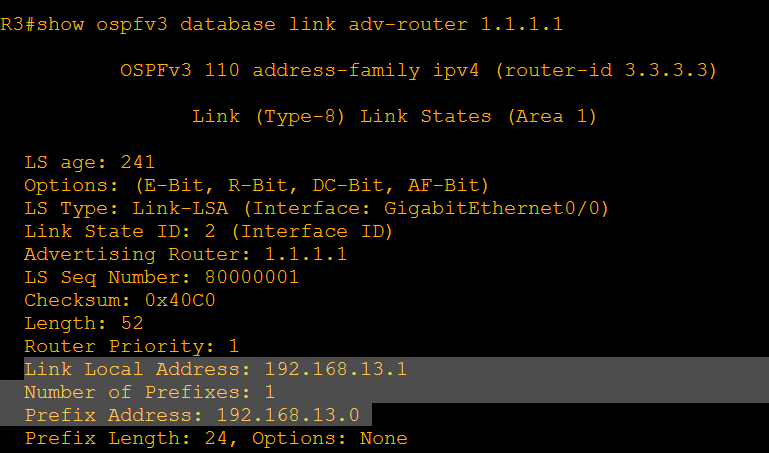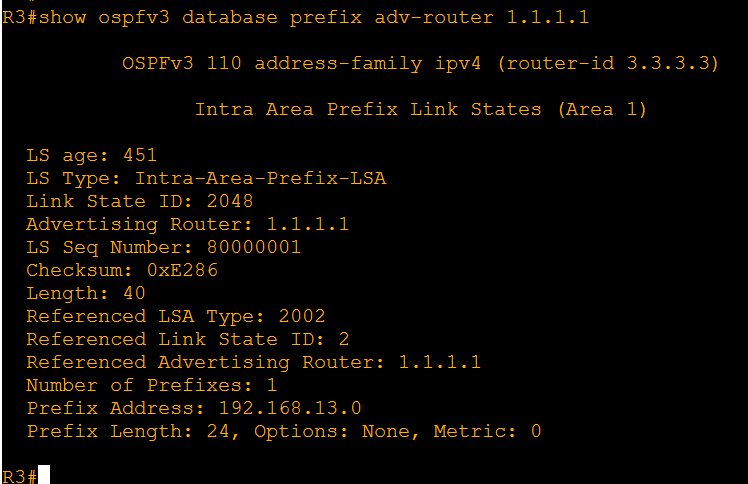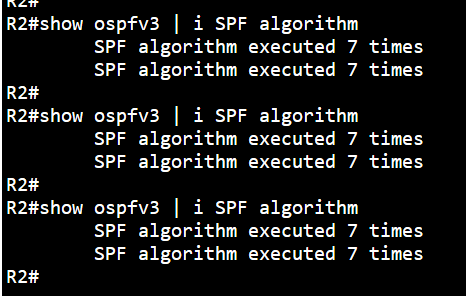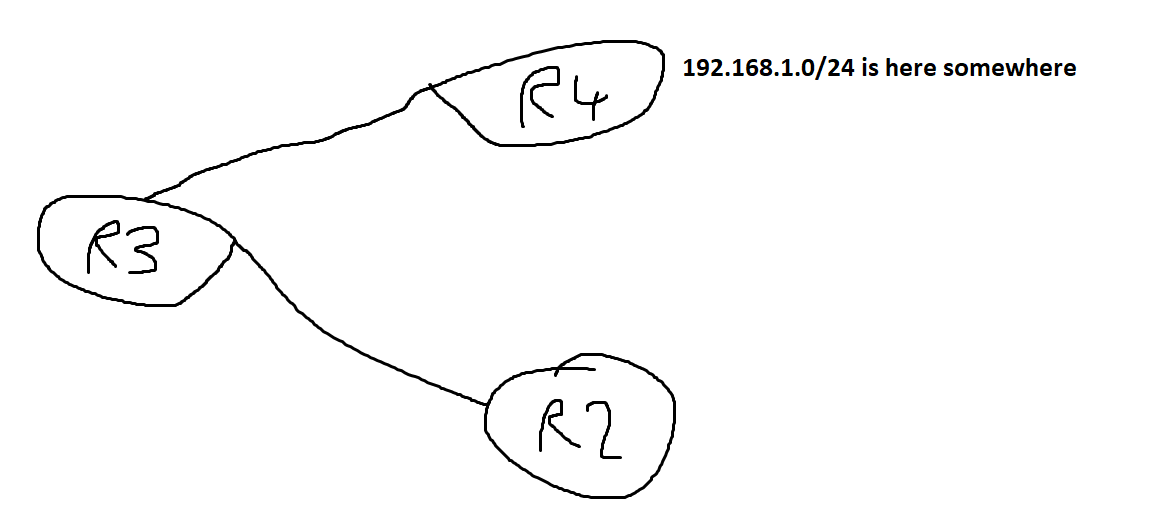This topic is to discuss the following lesson:
Hi Rene,
“Links, not networks” what do mean at this point, can you please explain in detail ? and can you give me an example about multiple instance ID in the same link ?
Hello Hussein
This is essentially a change in semantics. In OSPFv2 we speak about networks. The destination network, the networks that are advertised. A network is expressed as, for example, 10.56.3.0/24. This is a destination or advertise network as far as OSPFv2 is concerned.
IN OSPFv3, the term that is used is link. This means that 2001:AB::0/64 found in the routing table for example is called a link in the context of OSPFv3.
The command to implement OSPFv3 on an interface is the following:
ipv6 ospf process-id area area-id [instance instance-id]
You can input this command several times with a different instance-id in each case and have the same interface (and subsequently its link) participate in multiple instances of OSPFv3.
I hope this has been helpful!
Laz
Thanks Laz
That was very helpful indeed.
Hi all,
The flooding scope 0x2 says in the lesson that “is used for LSAs that are flooded throughout a single area”. LSA Type 3 and 4 are flooded throughout all ospf areas like the LSA Type5. Shouldn’t they also have the flooding scope 0x4?
Thanks in advance.
Hello Marios
Actually, if you take a closer look at Type 3 and Type 4 LSAs, you will find that they are not flooded throughout the whole AS scope. Looking at the related lesson about OSPFv2 LSAs, you can see that both are generated by an ABR that receives a Type 1 LSA. They are flooded to the rest of the network, but not in the OSPF area from which the Type 1 LSA is received.
The only LSA that truly exists throughout the whole AS in all OSPF areas is a Type 5 LSA, and it is the only one that begins with 0x4.
I hope this has been helpful!
Laz
Hi,
Regarding the statement:
By separating the SPF tree and prefixes, OSPFv3 is more efficient. When the link-local address on an interface changes, the router only has to flood an updated link LSA and intra-area-prefix LSA. Since there are no changes to the topology, we don’t have to flood type 1 and 2 LSA(s). Other routers won’t have to run SPF in this case.
Is it also correct to say that is more efficient because prefix information is not being repeated, as Type-1 and Type-2 LSAs can contain the same network information. e.g. if router 1 and router 2 are connected network. Both their Type-1 LSAs contain the same prefixes for the same link.
Thanks
Sam
Hello Samir
Yes, what you say makes sense because you are not duplicating information that has already been sent.
Laz
Hi dear,
I have a question? How can loops occur in OSPF? and how to differentiate L2 loops and L3 loops?
Hello Zahid
Concerning loops in OSPF, take a look at this post:
Concerning L2 and L3 loops, a layer 2 loop also known as a switching loop, or a bridging loop, is one where there is more than one layer 2 paths between two endpoints. A layer 2 loop will take place when
- there are multiple connections between two network switches on the same VLAN
- two ports on the same switch on the same VLAN are directly connected
- three or more switches are connected in a physical loop using ports on the same VLAN
Unlike Layer 3 loops, which employ a time to live (TTL) function, switching loop packets will circulate the network until they are dropped, e.g. due to resource exhaustion.
Layer 2 loops are dealt with using features such as STP, Etherchannel, or the creation of VLANs within the topology
A layer 3 loop also known as a routing loop takes place when routing is configured in such a way to send an IP packet continuously around the same path. This differs from a switching loop in that the loop is created due to routing decisions. This means that a looped IP packet will be routed from one subnet to another (or from one VLAN to another) resulting in a continuously looped packet.
This is primarily due to misconfiguration or a routing algorithm error. Unlike Layer 2 loops, IP packets have a TTL value that is decremented every hop, and when it reaches zero, it is dropped. Layer 3 loops are mitigated against using TTL as well as using correct routing configurations.
I hope this has been helpful!
Laz
Hi
In ospfv3 is possible to configure different instances in a single interface.
<64-95> for ipv4
<0-31> for ipv6
Where these range come from?
Hello Giovanni
I’m not sure what configuration parameters you are referring to. HOwever, I went into the lab and attempted to take a look at the process IDs that I was allowed to add for both IPv4 and IPv6 OSPF instances.
For IPv4:
R1(config)#inter gig 0/0
R1(config-if)#ip ospf ?
<1-65535> Process ID
adjacency Adjacency staggering
authentication Enable authentication
Similarly for IPv6:
R1(config-if)#ipv6 ospf ?
<1-65535> Process ID
adjacency Adjacency staggering
authentication Enable authentication
I was able to create two instances, one with a process ID of 100 for IPv6 and one with a process ID of 99 for IPv4 on the interface itself.
Under what configurations do you get these ranges of values for each protocol version? Let us know so that we can help you further.
I hope this has been helpful!
Laz
Hi
I’m referring to an ospfv3 instances on a single interface.
Here an example.
R1-Hub(config)#interface lo0
R1-Hub(config-if)#ipv6 enable
R1-Hub(config-if)#ospfv3 1 ipv6 are
R1-Hub(config-if)#ospfv3 1 ipv6 area 0 instance ?
<0-31> Instance ID
R1-Hub(config-if)#ospfv3 1 ipv4 area 0 instance ?
<64-95> Instance ID
R1-Hub(config-if)#ospfv3 1 ipv4 area 0 instance 1
^
% Invalid input detected at '^' marker.
Also, can you tell me when it is useful to configure more than one instance with the same interface and the same area?
R1-Hub(config-if)#ospfv3 1 ipv4 area 0 instance 65
R1-Hub(config-if)#ospfv3 1 ipv4 area 0 instance 66
R1-Hub(config-if)#ospfv3 1 ipv4 area 0 instance 67
R1-Hub(config-if)#
Hello Giovanni
Ah, I see, thanks for the clarification. One of the advancements of OSPFv3 over OSPFv2 is the use of the instance ID. This instance ID is an 8 bit field within the OSPFv3 header.
The original intent for the instance ID was to support multiple instances of OSPFv3 to run on the same interface. In this way, you can manipulate which routers on a particular segment are allowed to form adjacencies. You could use an instance number of 0 through 255 to distinguish between the different OSPFv3 instances.
However, within RFC 5838, the instance ID was re-purposed to be used to support address families (AFs) with OSPFv3. The default instance of 0 is used if no other instance is defined. However, specific ranges of the instance ID map to specific AFs. According to the RFC, these ranges are:
Instance ID # 0 - # 31 IPv6 unicast AF
Instance ID # 32 - # 63 IPv6 multicast AF
Instance ID # 64 - # 95 IPv4 unicast AF
Instance ID # 96 - # 127 IPv4 multicast AF
Instance ID # 128 - # 255 Unassigned
As you can see, 0-31 matches with the available values for the command using IPv6 unicast, while the same is true for IPv4 unicast. Note here that OSPFv3 runs on top of IPv6 and uses IPv6 link-local addresses to form OSPFv3 adjacencies. However, OSPFv3, using these instance IDs can now advertise IPv4 routes too. Note also that Cisco routers do not support multicast OSPF, so you don’t see those instance ID values at all in any of the Cisco configuration options.
Using instances within the same process simply allows you to create a more hierarchical routing environment. Within the same segment, you can choose which routers create adjacencies and which do not. You can essentially create a more granularly configurable routing protocol. The truth is that such configurations are highly specialized and generally rare. Because of this, the instance ID was leveraged for use with multiple AFs.
I hope this has been helpful!
Laz
could anyone please help me understand LSA type 1 and 2 in ospfv3 how does they not cause SPF recalculation as stated by Rene below.
If you make a simple change, like changing the IP address on one of your routers then the topology itself doesn’t change. In OSPFv2, a new type 1 LSA and perhaps a type 2 LSA have to be flooded. Other routers that receive the new LSA(s) have to recalculate the SPT even though the topology did not change.
In OSPFv3, they changed this by creating a separation between prefixes and the SPF tree. There is no prefix information in LSA type 1 and 2, you only find topology adjacencies in these LSAs, you don’t find any IPv6 prefixes in them. Prefixes are now advertised in type 9 LSAs and the link-local addresses that are used for next hops are advertised in type 8 LSAs. Type 8 LSAs are only flooded on the local link, type 9 LSAs are flooded within the area. The designers of OSPFv3 could have included link-local addresses in type 9 LSAs but since these are only required on the local link, it would be a waste of resources.
Hello Daro,
Let me try to clarify. OSPF uses LSA types 1 and 2, which contain information about prefixes as well as the SPF (Shortest Path First) tree. The SPF tree is a data structure used by OSPF to represent the network topology and calculate the shortest path to each destination.
Now each OSPF router will recalculate the SPF tree every time it receives a new Type 1 or 2 LSA. If however, you simply change the IP address of one of the interfaces of one of the routers, the prefix will change, but the SPF tree will not. In such a case, the SPF algorithm doesn’t really need to be run again by an OSPF router. But it will be run again whenever an LSA is received. This is somewhat inefficient, but is simply how OSPFv2 has been designed.
OSPFv3 has separated the prefix information from the SPF tree information in order to resolve this issue, and make it more efficient. LSA types 1` and 2 now contain only topology adjacencies, that is, information about the SPF tree. The prefix information and next-hop link-local addresses are contained within Types 9 and 8 respectively.
The result is that if you simply change the IP address of an interface, only a type 9 LSA will be sent. Type 9 LSAs do not trigger an SPF recalculation, thus neighboring OSPF routers will learn about the prefix change, but will know that the SPF tree remains the same, thus, they will not rerun the algorithm! They will only run the algorithm when a type 1 or 2 LSA is received. Does that make sense?
Now note that OSPFv3 was originally designed for IPv6, and that’s why it talks about LSA type 8 which contains link-local addresses of the next-hop routers. But OSPFv3 can also be used for IPv4, which still takes advantage of the separation of the SPF tree from the prefixes using types 1 and 2 as well as type 9 LSAs.
I hope this has been helpful!
Laz
Hello, everyone.
Why do link LSAs even exist? This is an LSA advertised by R1 to R3 (they are connected to the same 192.168.13.0/24 segment).
It advertises its link local address which is used as the next hop. The RFC defines it the following way:
The router inserts its link-local address on Link L into the link-
LSA. This information will be used when the other routers on Link
L do their next-hop calculations (see Section 4.8.2).
Why do intra-area prefix LSAs also include network information, then?
These two LSAs appear to have somewhat similar information. Any idea why they created two of them? Considering that most of their data seems.. redundant. Why include a link-local address in them if you already know it from the OSPF hellos? Why include the network associated with that link when you can just learn it from a type 9 LSA?
The only reason that I can think of is that in OSPF an LSA can have three types of scopes - link-scope (doesn’t get spread around the area, just between the two neighbors), area-scope (just the area), and AS-scope.
The type 8 is link-scoped, the type 9 isn’t. Isn’t this an SPF efficiency thing? Routers on the same link as a router advertising a prefix can directly attach that prefix to their local instance of that link, whereas routers not on that link that are in the area use the type 9 to reference the router LSA instead and then use the SPF tree.
Also, since link LSAs have a link-local flooding scope, doesn’t this mean that the routers in the same area will actually not have the same LSDB? Considering that the link LSA from one segment will never make it to another segment.
Thank you.
David
Hello David
As you know, OSPFv3 has been developed to support IPv6. Link LSAs or Type 8 LSAs as well as Intra Area prefix LSAs or Type 9 LSAs were explicitly introduced for IPv6. Type 8 is used to provide local information, such as link-local addresses and directly connected prefixes, while Type 9 is used to advertise actual routable prefixes in the area.
As stated in the lesson:
In OSPFv3, they changed this by creating a separation between prefixes and the SPF tree. There is no prefix information in LSA type 1 and 2, you only find topology adjacencies in these LSAs, you don’t find any IPv6 prefixes in them. Prefixes are now advertised in type 9 LSAs and the link-local addresses that are used for next hops are advertised in type 8 LSAs. Type 8 LSAs are only flooded on the local link, type 9 LSAs are flooded within the area.
In other words, engineers decided to decouple the prefix information from the topology information. Types 1 and 2 only contain topology information, while 8 and 9 contain prefix information. This decoupling gives more flexibility to OSPF, allowing it to send only the information that is needed at any point in time (topology or prefix) rather than having to send all the info simply because it is contained within the same LSA type by definition!
Now on to your question. When using IPv6, the distinct role that type 8 and 9 LSAs have is much clearer, because of the nature of the IPv6 link-local address and how it is used by routing protocols such as OSPF. But when you use it for IPv4, as you have done here, the difference between type 8 and 9 LSAs is less clear.
Whether you’re using IPv6 or IPv4, OSPFv3’s structure and operation remain the same. Type 8 LSAs still provide per-interface information that is not globally flooded, so they inform directly connected neighbors of local addressing and link characteristics, while type 9 advertises prefixes in the whole area.
So even though there may be some duplication of information, these LSAs serve different purposes, and together they replace what OSPFv2 placed in LSA Types 1 and 2. It may feel redundant, but in OSPFv3 it’s actually a higher degree of modularization. Does that make sense?
I hope this has been helpful!
Laz
Hello, everyone.
Here is my topology:
In v3, routers do not appear to include links that connect to stub networks in type 1/2 LSAs.
R4(config-if)#do show ospfv3 database router adv-router 4.4.4.4 | i Stub
This provides no output at all, there is no information about a link connecting to a stub network.
Even if I shutdown that link and enable it again, the other routers never run a full SPF.
These links aren’t included in that LSA at all. All that we have is the prefix in T8/T9 LSAs. Routers like R2 or R3 literally view the LSDB and the resulting SPT like this:
I think I understand why it works this way but I have to confirm.
Since that link is a stub network, it is obvious that it connects to R4 somewhere. Regardless of whether that interface is enabled, disabled, or an IP address is changed, nothing changes from the perspective of the physical paths in the LSDB/SPT. If I shutdown the stub network then nothing really changes apart from prefix information. The physical paths all remain the same. As far as SPT is concerned, no physical paths to reach a destination were broken.
Since the stub network is not part of the transit physical path to reach a destination (it literally is the destination itself), we don’t run full SPF on it. All we are concerned about is the prefix information in this case.
Do I understand this right?
It’s this difference between a full SPF and partial SPF that is often confusing. Full SPF is run when physical paths have to be re-evaluated (something in the type1/2 LSA changes). Partial SPF is run when something changes in the other LSAs, that’s pretty much another benefit of multi-area OSPF (you are only aware of your own area and run a partial SPF for the other areas).
Thank you
David
Hello David
Yes, you are very much on the right track. This all stems from a specific improvement from v2 to v3. Type 1 and Type 2 LSAs no longer carry ANY IP addressing information. Addressing is carried within Type 8 and 9 LSAs, (a new LSA types for v3). This separation of addressing info (Types 8 and 9) and topology information (Types 1 and 2) is called “decoupling”. So topology and addressing info are decoupled from being contained in the same LSA, to being contained in different LSAs.
When you look at the OSPFv3 LSDB using the show ospfv3 database router adv-router 4.4.4.4 | i Stub command, you get no output because OSPFv3 Router LSAs do not contain stub network information by design. This is expected and correct behavior. To see the stub prefixes in OSPFv3, take a look at this Cisco document that talks more about these LSAs and the commands used to view them:
You have identified one of the benefits of this decoupling!! When you shutdown a stub interface a topology check takes place: “Did the router lose a connection to another router?” No, the Type 1 and 2 LSAs are unchanged (i.e. the topology remains the same), so the router’s position in the network graph and its connections to other routers haven’t changed
If however there is a prefix update, the Type 9 Intra-Area-Prefix LSA is updated to remove (or add) the prefix. Other routers receive the Type 9 update but do NOT run full SPF because the topology (Type 1/2 LSAs) didn’t change. That’s why your statement is correct:
“Since the stub network is not part of the physical path to reach a destination (it literally is the destination itself), we don’t run full SPF on it.”
So from your experimentation, you have seen first hand how OSPFv3’s separation of topology LSAs from prefix LSAs is a design improvement that prevents unnecessary full SPF calculations when only reachability information changes.
I hope this has been helpful!
Laz





